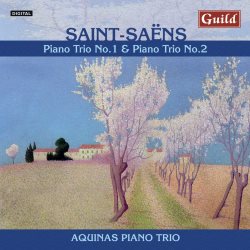| 
|
Camille SAINT-SAňNS (1835-1921)
Piano Trio No. 1 in F major Op. 18 [26:33]
Piano Trio No. 2 in E minor Op. 92 [33:50]
Aquinas Piano Trio (Ruth Rogers (violin), Katherine Jenkinson (cello),
Martin Cousin (piano))
rec. Wyastone Concert Hall, Wyastone Leys, Monmouthshire, 22-23 February
2013 (No. 1) and Old Granary Studio, Norfolk, 26-27 September 2008 (No.
2)
GUILD GMCD7408 [61:08]
The
two Piano Trios of Saint-SaŽns date from 1863 and 1892 respectively,
and differ greatly in character. Not in merit, however, as both must
surely rank amongst not only the composer’s best works but amongst the
very greatest of piano trios. They are astonishingly fresh but at the
same time very finished works, immediately engaging for the listener
yet repaying more detailed study. The piano trio medium can sound
somewhat overblown in other hands but Saint-SaŽns achieves a miraculous
clarity of texture in each of these works.
The earlier Trio takes the listener straightaway in imagination to a
very cultured salon, with supremely cultivated, intelligent and often
witty conversation between the players. This is certainly no mere
chit-chat, and each movement is a delight. Pope’s lines “What oft was
thought but ne’er so well expressed” sum this work up for me. The
Second Trio is a more ambitious work, in five movements, and longer
overall. The first movement is one of the composer’s most successful
creations, being both apparently spontaneous and at the same time
organically conceived and well constructed. The second movement has
real charm, its 5/8 metre cunningly disguised so as often to sound as
though the players are indulging in some sort of strange rubato.
Both Trios make considerable demands on the players whilst their very
urbane character requires that this should not be obvious to the
listener. The Aquinas Piano Trio was only formed in 2009 but has the
skill to meet their requirements in abundance. Each movement is
characterised with great precision. There are many rival versions of
this coupling in the catalogues but I would be surprised if this was
not the equal of the best of them. Excellent notes by Robert
Matthew-Walker and a clear if close recording add to the attractions of
this issue.
John Sheppard
 |
 |
|
